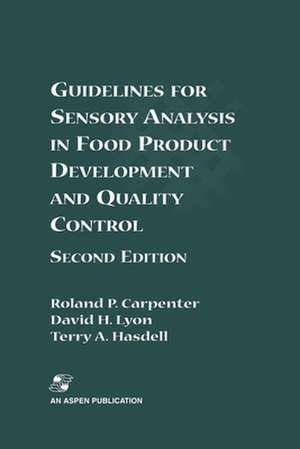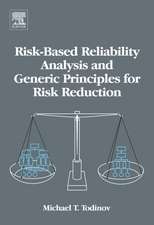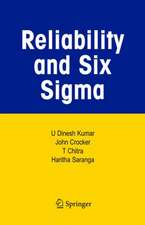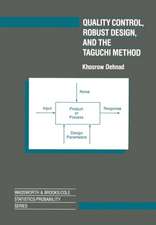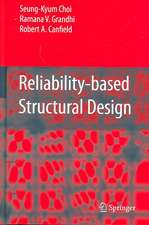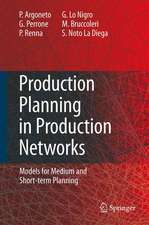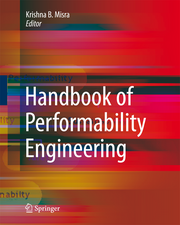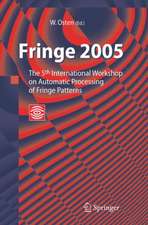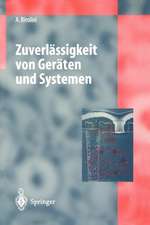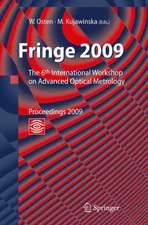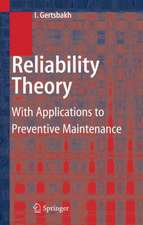Guidelines for Sensory Analysis in Food Product Development and Quality Control
Autor Roland P. Carpenter, David H. Lyon, Terry A. Hasdellen Limba Engleză Paperback – 30 apr 2000
Preț: 644.18 lei
Preț vechi: 757.85 lei
-15% Nou
Puncte Express: 966
Preț estimativ în valută:
123.28€ • 133.86$ • 103.55£
123.28€ • 133.86$ • 103.55£
Carte tipărită la comandă
Livrare economică 22 aprilie-06 mai
Preluare comenzi: 021 569.72.76
Specificații
ISBN-13: 9780834216426
ISBN-10: 0834216426
Pagini: 210
Ilustrații: XXVIII, 210 p. 2 illus.
Dimensiuni: 152 x 229 x 25 mm
Greutate: 0.52 kg
Ediția:2nd ed. 2000. Softcover reprint of the original 2nd ed. 2000
Editura: Springer Us
Colecția Springer
Locul publicării:New York, NY, United States
ISBN-10: 0834216426
Pagini: 210
Ilustrații: XXVIII, 210 p. 2 illus.
Dimensiuni: 152 x 229 x 25 mm
Greutate: 0.52 kg
Ediția:2nd ed. 2000. Softcover reprint of the original 2nd ed. 2000
Editura: Springer Us
Colecția Springer
Locul publicării:New York, NY, United States
Public țintă
ResearchCuprins
1—What Is Sensory Analysis Used for?.- 1.1 Providing Answers to Practical Questions.- 1.2 Specifications and Quality Control.- 1.3 Shelf-Life Studies.- 1.4 Taint Potential.- 1.5 Product Matching.- 1.6 Product Reformulation.- 1.7 Product Mapping.- 1.8 Product Acceptability.- 2—The Relationship of Physiology and Psychology to Sensory Analysis.- 2.1 Introduction.- 2.2 What Role Do the Senses Play?.- 2.3 How Do the Senses Interact?.- 2.4 Thresholds and Sensitivity.- 2.5 Individual Differences.- 2.6 Perception—The Link with the Senses.- 2.7 Which Psychological Factors May Affect Sensory Results?.- 3—How To Use Sensory Analysis To Meet Your Objective.- 3.1 Formulating the Objective.- 3.2 Decisions about Data.- 3.3 Tests Used To Achieve the Objective.- 3.4 Principles of Questionnaire Design.- 4—The Products for Sensory Analysis.- 4.1 The Nature of the Products.- 4.2 The Number of Products.- 4.3 The Assessment of the Products.- 5—Who Are the Right People for Sensory Analysis?.- 5.1 What Type of Person Is Required?.- 5.2 Selecting People for Specific Tasks.- 5.3 How Many Assessors?.- 5.4 How To Select Assessors.- 5.5 How To Train Assessors.- 5.6 Health and Welfare of Assessors.- 6—Experimental Design and Data Analysis.- 6.1 Experimental Design.- 6.2 Data Analysis.- 7—Reporting and Recording.- 7.1 Style and Content.- 7.2 Background and Objectives.- 7.3 Methods.- 7.4 Analysis of Data.- 7.5 Presentation of Results.- 7.6 Interpretation and Discussion of Results.- 7.7 Conclusions.- 7.8 Recommendations.- 7.9 Retaining Records.- 8—Putting Sensory Analysis into Practice.- 8.1 Resources.- 8.2 Practical Constraints.- 8.3 Organizing The Sensory Test.- 8.4 Assessor Briefing and Motivation.- 8.5 Setting Standards for Sensory Panels.- 8.6 Monitoring Performance of Assessors and the Panel.- 9—Case History: Specification and Quality Control.- 9.1 Background.- 9.2 Method and Approaches.- 9.3 Implementation.- 10—Case History: Shelf-Life Studies.- 10.1 Background.- 10.2 Methods and Approaches.- 10.3 Analysis and Presentation of Results.- 11—Case History: Taint Investigation.- 11.1 Background.- 11.2 Methods.- 11.3 Results.- 12—Case History: Taint Prevention.- 12.1 Background.- 12.2 Methods.- 12.3 Results.- 13—Case History: Mapping of Coffee Products.- 13.1 Introduction.- 13.2 Aims.- 13.3 Descriptive Analysis of Coffee.- 13.4 Implications for Product Matching/Mapping.- 13.5 Consumer Preferences for Coffee.- 13.6 Relating Consumer Preferences to Sensory Attributes.- 13.7 Implications for Product Matching/Mapping.- 14—Case History: Quality Control in Product Batching.- 14.1 Background.- 14.2 Methods and Approaches.- 14.3 Recommendations.- 15—Case History: Graphical Methods for Monitoring Profile Panel Performance.- 15.1 Introduction.- 15.2 Methods and Results.- 15.3 Conclusions.- Appendixes.- Appendix A—Some Useful Tables for Sensory Tests.- Appendix B—Glossary of Terms Used in Sensory Analysis.- Appendix C—Some Useful Contacts.
